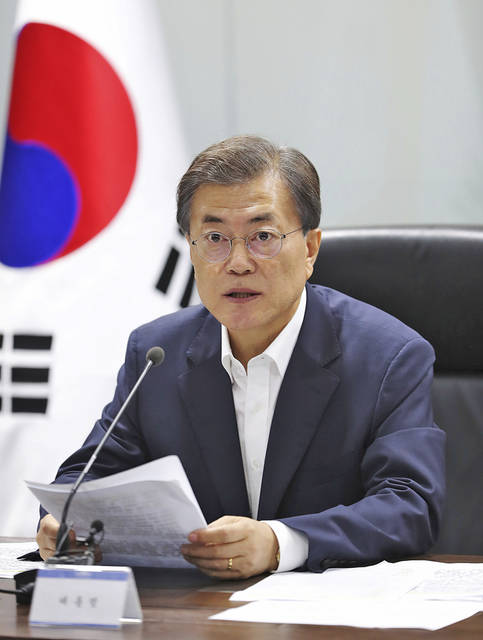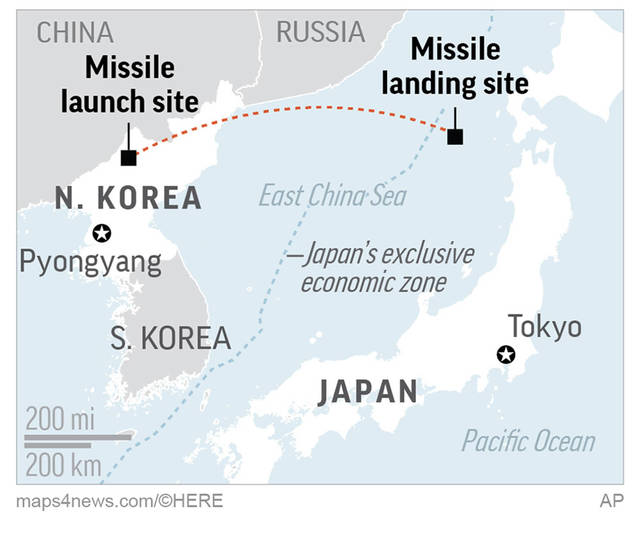PYONGYANG, North Korea — North Korean leader Kim Jong Un said Saturday the second flight test of an intercontinental ballistic missile demonstrated his country can hit the U.S. mainland, hours after the launch left analysts concluding that a wide swath
PYONGYANG, North Korea — North Korean leader Kim Jong Un said Saturday the second flight test of an intercontinental ballistic missile demonstrated his country can hit the U.S. mainland, hours after the launch left analysts concluding that a wide swath of the United States, including Los Angeles and Chicago, is now in range of North Korean weapons.
The Korean Central News Agency said that Kim expressed “great satisfaction” after the Hwasong-14 missile reached a maximum height of 2,314 miles and traveled 620 miles before accurately landing in waters off Japan. The agency said that the test was aimed at confirming the maximum range and other technical aspects of the missile it says was capable of delivering a “large-sized, heavy nuclear warhead.”
Analysts had estimated that the North’s first ICBM on July 4 could have reached Alaska, and said that the latest missile appeared to extend that range significantly.
Immediately after the launch, U.S. and South Korean forces conducted live-fire exercises. South Korean Defense Minister Song Young-moo called for the deployment of strategic U.S. military assets — which usually means stealth bombers and aircraft carriers — as well as additional launchers of an advanced U.S. anti-missile system.
Japanese government spokesman Yoshihide Suga said the missile, launched late Friday night, flew for about 45 minutes — about five minutes longer than the first. The missile was launched on very high trajectory, which limited the distance it traveled, and landed west of Japan’s island of Hokkaido.
The KCNA quoted Kim as saying that the launch reaffirmed the reliability of the country’s ICBM system and an ability to fire at “random regions and locations at random times” with the “entire” U.S. mainland now within range. The agency said that the test confirmed important features of the missile system, such as the proper separation of the warhead and controlling its movement and detonation after atmospheric re-entry.
Kim said the launch sent a “serious warning” to the United States, which has been “meaninglessly blowing its trumpet” with threats of war and stronger sanctions, the KCNA said.
The North Korean flight data was similar to assessments by the United States, South Korea and Japan.
David Wright, a physicist and co-director of the global security program at the Union of Concerned Scientists, said that if reports of the missile’s maximum altitude and flight time are correct, it would have a theoretical range of about 6,500 miles. That means it could have reached Los Angeles, Denver or Chicago, depending on variables such as the size and weight of the warhead that would be carried atop such a missile in an actual attack.
President Donald Trump issued a statement condemning the missile test as a threat to the world, and rejecting North Korea’s claim that nuclear weapons ensure its security. “In reality, they have the opposite effect,” he said.
Trump said the weapons and tests “further isolate North Korea, weaken its economy, and deprive its people.” He vowed to “take all necessary steps” to ensure the security of the U.S. and its allies.
Washington and its allies have watched with growing concern as Pyongyang has made significant progress toward its goal of having all of the U.S. within range of its missiles to counter what it labels as U.S. aggression. There are other hurdles, including building nuclear warheads to fit on those missiles and ensuring reliability. But many analysts have been surprised by how quickly leader Kim Jong Un has developed North Korea’s nuclear and missile programs despite several rounds of U.N. Security Council sanctions that have squeezed the impoverished country’s economy.
Trump has said he will not allow North Korea to obtain an ICBM that can deliver a nuclear warhead. But this week, the Defense Intelligence Agency reportedly concluded that the North will have a reliable ICBM capable of carrying a nuclear weapon as early as next year, in an assessment that trimmed two years from the agency’s earlier estimate.
Japanese Prime Minister Shinzo Abe called the launch a “serious and real threat” to the country’s security.
Suga, the Japanese spokesman, said Japan has lodged a strong protest with North Korea. “North Korea’s repeated provocative acts absolutely cannot be accepted,” he said.
The French Foreign Ministry condemned the launch and called for “strong and additional sanctions” by the United Nations and European Union. “Only maximal diplomatic pressure might bring North Korea to the negotiating table,” the ministry said in a statement.
“This is a 4G threat: global, grave, given and growing,” France’s U.N. Ambassador Francois Delattre told The Associated Press. That’s why we call for a firm and quick reaction including the adoption of strong additional sanctions by the Security Council.”
A spokesman for Gen. Joseph Dunford, chairman of the Joint Chiefs of Staff, said that Dunford met at the Pentagon with the commander of U.S. forces in the Pacific, Adm. Harry Harris, to discuss U.S. military options in light of North Korea’s missile test.
The spokesman, Navy Capt. Greg Hicks, said Dunford and Harris placed a phone call to Dunford’s South Korean counterpart, Gen. Lee Sun Jin. Dunford and Harris “expressed the ironclad commitment to the U.S.-Republic of Korea alliance,” Hicks said, referring to the U.S. defense treaty that obliges the U.S. to defend South Korea.




